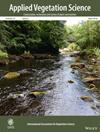Tracking floristic archetypes of Patagonian steppes
Abstract
Questions
The classification of plant communities is a well-established practice in ecology. However, the factors that determine the distribution of common species and the extent of their dominance and overlap are still being debated. Large-scale studies based on field data are of great interest in the face of biodiversity changes and climate change impacts. This research was designed to answer the following two questions: What are the dominant plant communities in the Patagonian steppes and how do they relate to environmental features, as measured by latitude, longitude, altitude, mean annual precipitation and mean temperature? What have been the recent changes in plant communities in terms of expansion and contraction of different types of communities?
Location
Patagonian steppes (South America).
Methods
We used a large database of species-by-species vegetation cover from 426 monitoring plots in the South American Patagonian steppes, surveyed between 2007 and 2019, with two different assessment dates at least 5 years apart. We applied archetypal analysis to identify different vegetation compositions at a regional scale (called floristic archetypes) and to track their changes over time. In addition, we analyzed the relationship between floristic archetypes and spatial and meteorological variables to assess the association between floristic composition and the environmental context.
Results
Seven floristic archetypes were identified in the Patagonian steppes. The dominant and most widespread floristic archetype showed an expanding pattern in floristic trajectories and was positively associated with mean annual temperature. This floristic archetype was characterized by both drought- and grazing-tolerant species. Two floristic archetypes located at the longitudinal extremes showed decreasing relative participation in the vegetation configurations, and the archetype located towards the west showed a positive relationship with annual precipitation, suggesting a threatened scenario in the face of drier conditions. Southern floristic archetypes either showed a slight decrease or remained stable.
Conclusions
Patagonian steppes are dominated by both drought- and grazing-tolerant species communities and their spatial distribution is expanding across different biomes, whereas the more forage-preferred species were associated with a decreasing floristic archetype. A projected drier and hotter climate scenario may potentiate this pattern. The floristic archetypes framework has potential as a monitoring tool for tracking changes in vegetation composition at a mesoscale and for identifying hotspots of vulnerable vegetation in the face of environmental changes.

 求助内容:
求助内容: 应助结果提醒方式:
应助结果提醒方式:


